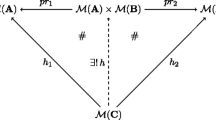Abstract
This article begins with a review of the framework of fuzzy probability theory.The basic structure is given by the σ-effect algebra of effects (fuzzy events) E(Ω,A) and the set of probability measures M + 1 (Ω, A) on a measurable space (Ω,A). An observable X: B → E(Ω, A) is defined, where (Λ, B) is the value spaceof X. It is noted that there exists a one-to-one correspondence between states onE(Ω, A) and elements of M + (Ω, A) and between observables X: B → E(Ω,A) and σ-morphisms from E(Λ, B) to E(Ω, A). Various combinations ofobservables are discussed. These include compositions, products, direct products,and mixtures. Fuzzy stochastic processes are introduced and an application toquantum dynamics is considered. Quantum effects are characterized from amonga more general class of effects. An alternative definition of a statistical map T:M + 1 (Ω, A) → M + 1 (Λ, B) is given.
Similar content being viewed by others
REFERENCES
E. G. Beltrametti and S. Bugajski, Quantum observables in classical frameworks, Int. J Theor. Phys. 34, 1221-1229 (1995).
E. G. Beltrametti and S. Bugajski, A Classical extension of quantum mechanics, J. Phys.A Math. Gen. 28, 3329-3334 (1995).
E. G. Beltrametti and S. Bugajski, The Bell phenomenon in classical frameworks, J. Phys.A Math. Gen. 29, 247-261 (1996).
E. G. Beltrametti and S. Bugajski, Effect algebras and statistical physical theories, J. Math.Phys. 38, 3020-3030 (1997).
S. Bugajski, Classical and quantal in one or how to describe mesoscopic systems, MolPhys. Rep. 11, 161-171 (1995).
S. Bugajski, Fundamentals of fuzzy probability theory, Int. J. Theor. Phys. 35, 2229-2244 (1996).
S. Bugajski, K.-E. Hellwig, and W. Stulpe, On fuzzy random variables and statistical maps, Rep. Math. Phys. 41, 1-11 (1998).
P. Busch, M. Grabowski, and P. J. Lahti, Operational Quantum Physics, Springer-Verlag, Berlin, 1995.
E. B. Davies, Quantum Theory of Open Systems, Academic Press, New York, 1976.
D. Foulis and M. K. Bennett, Effect algebras and unsharp quantum logics, Found. Phys. 24, 1331-1352 (1994).
R. Greechie and D. Foulis, Transition to effect algebras, Int. J. Theor. Phys. 34, 1369-1382 (1995).
S. Gudder, Fuzzy probability theory, Demon. Math. 31, 235-254 (1998).
S. Gudder, What is fuzzy probability theory? to appear.
A. S. Holevo, Probabilistic and Statistical Aspects of Quantum Theory, North-Holland, Amsterdam, 1982.
G. Ludwig, Foundations of Quantum Mechanics, Vols. I and II, Springer-Verlag, Berlin, 1983/1985.
Author information
Authors and Affiliations
Rights and permissions
About this article
Cite this article
Gudder, S. Combinations of Observables. International Journal of Theoretical Physics 39, 695–704 (2000). https://doi.org/10.1023/A:1003698023288
Issue Date:
DOI: https://doi.org/10.1023/A:1003698023288




